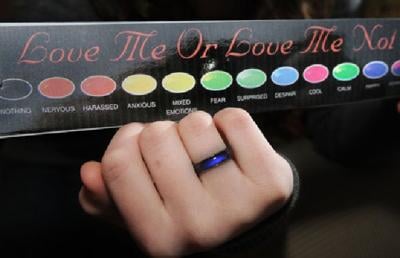The idea behind a mood ring is simple: Wear it on your finger and it will reflect the state of your emotions.
But, how does it work?
There isn't a crystal ball to peer into to explain it, but crystals in the ring "globe" are a defining element.
As the inside of the ring conducts heat from your finger, the temperature-sensitive liquid crystals in the "stone" move into action. These crystals are the secret to the ring's success, changing position or twisting according to temperature fluctuation. This affects the wavelengths of color absorbed or reflected, and the resulting color spectrum. A green shade signifies "average" on the mood ring color scale, and is calibrated to the surface temperature of a typical person, approximately 82 degrees Fahrenheit.
Warmer temperatures generally result in violet-blues and blues, the cooler temperatures in browns and blacks. If you take a mood ring off, it will normally change to black unless the ambient temperature is very high.
While mood rings cannot reflect your mood with any real scientific accuracy, they actually are indicators of your body's involuntary physical reaction to your emotional state.
Explanatory color charts are Web-wide, included in blogs and on product sites.
Here is a summary color chart culled from a variety of sources:
SHADES OF BLACK AND GRAY: Black is seen mostly when the ring is not worn, but can also indicate nervousness, stress, overwork or sickness. The color gray appears when the person is afraid, anxious or feeling exhausted.
WHITE: It can mean boredom, frustration or confusion.
GREEN SHADES: With typical green, the mood is ideal, calm and peaceful. Dark emerald green can indicate feelings of awareness and involvement. And, if the ring turns bright green, it may mean the person is inquisitive and interested.
FEELING BLUES: Deep teal means the ring wearer is motivated and experiencing deep thinking. Plain blue indicates relaxation, happiness and peacefulness, while dark blue can be related to feelings of passion and romance. If the ring goes indigo, look for feelings of satisfaction and tranquillity, and aquamarine blue may indicate an upbeat or flirtatious mood. And with cobalt blue, the person can appear pleasant, open to other people.
REDS: A shade of deep red may evolve from feelings of passion and love, while bright red can mean the person is excited, adventure-seeking or even angry or shocked.
SUNNY SIDES: When it comes to the yellow/oranges on the ring, dark orange indicates feelings of nervousness, aggressiveness, worry and exasperation, and a yellow-orange shade shows that the person is upset, confused or a bit nervous. With a bright yellow, the ring wearer is studying a subject hard or expressing feeling through poetry.
BROWNS: Dark brown is associated with restlessness, tensions and fear, brownish-yellow indicates the person is feeling mixed emotions, and taupe hints at feelings of stress, unpredictability, angst or aggravation.
IN THE PINKS: Pink can indicate a feeling of rest and peacefulness, and bright pink, that a person may feel loving, affectionate or happy. With light pink, the ring wearer may be fearful or uncertain.
PURPLES: Deep purple means the person is feeling passionate, romantic, while reddish purple may be a sign of anger, despair or moodiness.
Sources: www.howstuffworks.com; www.ezinearticles.com; sheofmermaids.blogspot.com; www.shopjustice.com.




